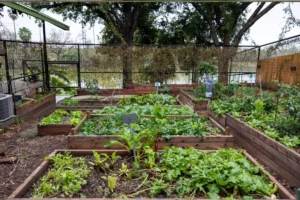Microgreens strong tastes, vivid colors, and high nutritious content have made them extremely popular in recent years. These young, tender greens are packed with various vitamins, minerals, and antioxidants, making them a valuable addition to any diet. Traditionally, microgreens were grown in open fields or on windowsills, but now, with advancements in technology, more and more growers are turning to controlled environments like greenhouses for their microgreen production. In this article, we will explore the benefits of grow microgreens in a greenhouse and provide a step-by-step guide on how to set up your own greenhouse for microgreen cultivation.
What are microgreens?
Before delving into the advantages of growing microgreens in a greenhouse, let’s first understand what microgreens are. Microgreens are basically seedlings of different vegetables and herbs. They are harvested when they are just a few inches tall and their first set of true leaves has emerged. These young greens are more mature than sprouts but not as developed as baby salad greens. Despite their small size, microgreens are packed with intense flavors and concentrated nutrients, making them a popular choice for chefs, health enthusiasts, and home gardeners.

Benefits of grow microgreens in a greenhouse
Extended growing season:
One of the major advantages of growing microgreens in a greenhouse is the ability to extend the growing season. Greenhouses provide a controlled environment where temperature, humidity, and light can be regulated, allowing for year-round production. This means you can enjoy fresh microgreens even during the colder months when outdoor growing is limited.
Protection from pests and diseases:
Greenhouses act as a physical barrier, protecting your microgreens from pests, insects, and diseases. By controlling the environment within the greenhouse, you can minimize the risk of infestations and disease outbreaks, resulting in healthier and higher-quality microgreens.
Optimal growing conditions:
Greenhouses provide the ideal conditions for microgreen growth. The controlled environment allows you to fine-tune factors such as temperature, humidity, and light intensity to create the perfect growing conditions for your chosen microgreen varieties. This results in faster and more consistent growth, ensuring a steady supply of microgreens throughout the year.
Controlled environments for growing microgreens
To successfully grow microgreens in a greenhouse, it is important to create a controlled environment that mimics the optimal conditions for their growth. Here some factored:
Temperature:
Microgreens thrive in temperatures ranging from 60 to 75 degrees Fahrenheit (15 to 24 degrees Celsius). Use a thermostat-controlled heater or cooling system to maintain the ideal temperature inside the greenhouse.
Humidity:
Microgreens require a moderately humid environment, with humidity levels around 50 to 70 percent. Use a humidifier or misting system to maintain the desired humidity levels within the greenhouse.
Lighting:
Adequate lighting is crucial for healthy microgreen growth. Greenhouses should ideally have access to natural sunlight, but supplemental lighting may be necessary during the darker months. Install grow lights with the appropriate spectrum to ensure sufficient light for your microgreens.
Ventilation:
Proper air circulation is essential to prevent the buildup of excess moisture and to provide fresh air for the microgreens. Install vents or fans in your greenhouse to ensure adequate ventilation.
Setting up a greenhouse for microgreen production
Now that we understand the benefits of growing microgreens in a greenhouse and the key elements of a controlled environment, let’s discuss how to set up your own greenhouse for microgreen production.

Choose the right greenhouse type:
There are various greenhouse types to choose from, including hoop houses, polytunnels, and glass greenhouses. Consider factors such as budget, space availability, and local climate when selecting the appropriate greenhouse type for your microgreen operation.
Prepare the greenhouse structure:
Ensure that the greenhouse structure is sturdy and well-maintained. Repair any damages, clean the interior, and install necessary equipment such as shelving, benches, and irrigation systems.
Install climate control systems:
To create a controlled environment, install a thermostat-controlled heating and cooling system to regulate the temperature. Additionally, consider installing a humidifier or misting system to maintain the desired humidity levels.
Provide adequate lighting:
Assess the natural lighting conditions in your greenhouse and determine if supplemental lighting is required. Install grow lights with the appropriate spectrum to ensure optimal light levels for your microgreens.
Set up irrigation and drainage systems:
Microgreens require consistent moisture levels. Install an efficient irrigation system that provides a steady supply of water to the growing trays or containers. Ensure proper drainage to prevent waterlogging, which can lead to root rot and other issues.
Create a suitable growing area:
Arrange your growing trays or containers in an organized manner, providing enough space for each microgreen variety. Consider using shelving or vertical systems to maximize space utilization.
Monitor and adjust environmental conditions:
Regularly monitor the temperature, humidity, and light levels within the greenhouse. Make necessary adjustments to ensure optimal growing conditions for your microgreens.
Choosing the right microgreen varieties for greenhouse cultivation
When growing microgreens in a greenhouse, it is important to select the right varieties that thrive in controlled environments. Here are some popular microgreen varieties suitable for greenhouse cultivation:
Basil:
Basil microgreens are known for their intense aroma and flavor. They grow well in controlled environments and can be harvested within a few weeks.
Radish:
Radish microgreens grow quickly and give foods a spicy edge. Because they can withstand a wide range of temperatures, they are an excellent option for growing in greenhouses.
Pea shoots:
Pea shoots are delicate and have a sweet, fresh taste. They grow well in greenhouses and can be harvested when they are a few inches tall.
Sunflower:
Sunflower microgreens have a nutty flavor and are rich in nutrients. They thrive in controlled environments and can be harvested when their first true leaves appear.
Broccoli:
Broccoli microgreens are packed with antioxidants and have a mild, slightly spicy taste. They grow well in greenhouses and can be harvested when they reach a suitable height.
Grow microgreens in a greenhouse: step-by-step guide
Now that you have set up your greenhouse and selected the appropriate microgreen varieties, let’s dive into a step-by-step guide on how to grow microgreens in a greenhouse:
Prepare the growing medium:
Fill your growing trays or containers with a suitable growing medium, such as potting soil or coconut coir. Make sure the medium is damp but not soggy.
Sow the seeds:
Evenly distribute the seeds over the growing medium, ensuring a dense but not overcrowded layer. To ensure good seed-to-soil contact, gently press the seeds into the medium.
Water the seeds:
Use a fine mist sprayer or gentle watering can to water the seeds. Refrain from overwatering as this can cause rot or mold. Keep the moisture content constant during the growth process.
Provide adequate light:
Place the trays in a well-lit area within the greenhouse. If natural light is insufficient, supplement with grow lights. Ensure that the lights are positioned at an appropriate distance to prevent heat damage to the microgreens.
Monitor and maintain environmental conditions:
Regularly check the temperature, humidity, and light levels within the greenhouse. Make necessary adjustments to maintain optimal growing conditions for your microgreens.
Harvest the microgreens:
Once the microgreens have reached the desired height and their first true leaves have emerged, it’s time to harvest. Just above the soil line, trim the microgreens with sharp scissors or clean scissors.
Common challenges and solutions in greenhouse microgreen production
While growing microgreens in a greenhouse offers many benefits, it also comes with its own set of challenges. The following are some typical problems you might run into and how to solve them:
Pest infestations:
Despite the controlled environment, pests can still find their way into your greenhouse. Regularly inspect your microgreens for signs of pests and take appropriate measures such as introducing beneficial insects or using organic pest control methods.

Disease outbreaks:
Fungal and bacterial diseases can affect microgreens grown in greenhouses. Practice good hygiene by regularly sanitizing your equipment and trays. If disease outbreaks occur, remove and destroy affected plants to prevent further spread.
Temperature:
Temperature swings are a possibility in greenhouses, particularly in severe weather. To guarantee ideal growing circumstances, keep a close eye on the temperature and modify as needed with heating or cooling systems.
Overwatering or underwatering:
Finding the right balance of moisture is crucial for microgreen growth. Avoid overwatering or underwatering by regularly checking the moisture levels in the growing medium. Adjust your watering schedule accordingly.
Harvesting and preserving greenhouse-grown microgreens
Once you have harvested your microgreens, it’s important to store them properly to maintain their freshness and quality. Here are some tips for harvesting and storing microgreens grown in a greenhouse:
Harvesting:
Use clean scissors or a sharp knife to harvest the microgreens just above the soil level. To prevent harming the fragile roots, refrain from tugging or pulling the greens.
Drying:
After rinsing, gently shake off excess water and pat the microgreens dry using a clean towel or paper towels. Avoid vigorous drying, as this can bruise or damage the greens.
Storage:
Place the microgreens in a clean, airtight container or resealable plastic bag lined with a paper towel. Store them in the refrigerator at a temperature of around 32 to 40 degrees Fahrenheit (0 to 4 degrees Celsius). Microgreens kept in the right conditions can keep for up to seven days.
Marketing and selling greenhouse-grown microgreens
Now that you have successfully grown and harvested your microgreens in a greenhouse, it’s time to market and sell them. Here are some strategies to consider:
Local markets:
Participate in local farmers’ markets or set up a booth at a community event. This allows you to connect directly with customers and showcase the freshness and quality of your greenhouse-grown microgreens.
Restaurants and chefs:
Reach out to local restaurants and chefs who prioritize farm-to-table ingredients. Offer samples and highlight the unique flavors and nutritional benefits of your microgreens.
Online platforms:
Create a website or utilize online platforms to sell your greenhouse-grown microgreens. Make use of social media to interact with potential customers and promote your items.
Subscription services:
Consider offering subscription services where customers receive regular deliveries of your microgreens. This provides a consistent customer base and ensures a steady income stream.
Final Thoughts
Start your own greenhouse microgreen production today and experience the benefits of year-round, high-quality microgreen cultivation. Take the first step by setting up your greenhouse and selecting the right microgreen varieties. Don’t miss out on the opportunities this controlled environment offers for grow microgreens in a greenhouse.